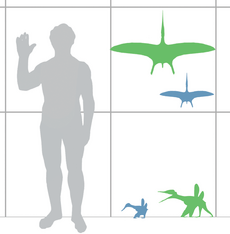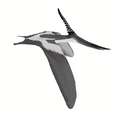Pterodactylus facts for kids
Quick facts for kids PterodactylusTemporal range: Upper Jurassic
|
|
|---|---|
 |
|
| Pterodactylus kochi | |
| Conservation status | |
|
Fossil
|
|
| Scientific classification | |
| Kingdom: | |
| Phylum: | |
| Class: | |
| Order: | |
| Suborder: | |
| Family: |
Pterodactylidae
|
| Genus: |
Pterodactylus
|
Pterodactylus means "winged finger." It was a type of flying reptile called a pterosaur. People often call them "pterodactyls." The most well-known species is Pterodactylus antiquus. It was the first pterosaur ever discovered and named!
Most Pterodactylus fossils have been found in a special type of rock called Solnhofen limestone in Bavaria, Germany. These fossils are from the late Jurassic Period. This means they lived about 150.8 to 148.5 million years ago. Some smaller pieces have also been found in other parts of Europe and Africa.
Pterodactylus was a carnivore, meaning it ate meat. It probably hunted fish and other small animals. Like all pterosaurs, Pterodactylus had wings. These wings were made of a membrane of skin and muscle. This membrane stretched from its very long fourth finger to its back legs.
Contents
What Did Pterodactylus Look Like?
Scientists have found over 30 Pterodactylus fossils. Most of these are from young animals. However, many of them have complete skeletons. Pterodactylus antiquus was a fairly small pterosaur. An adult had a wingspan of about 1.04 meters (about 3.4 feet). That's roughly the length of a small car!
Other "species" of Pterodactylus were once thought to be even smaller. But scientists later realized these were just young Pterodactylus. They also found that some were young versions of other pterosaurs. These included relatives like Ctenochasma and Germanodactylus.
Skull and Teeth of Pterodactylus
The skulls of adult Pterodactylus were long and thin. They had about 90 narrow, cone-shaped teeth. These teeth went all the way from the tip of the jaw to the back. The teeth became smaller the further back they were in the jaw.
Unlike some of its relatives, Pterodactylus had teeth at the very front of its upper jaw. Its teeth also went further back into the jaw. Some teeth were even found below the large opening in the skull called the nasoantorbital fenestra. The skull and jaws of Pterodactylus were straight, not curved upwards.
Did Pterodactylus Have a Head Crest?
Yes, Pterodactylus had a crest on its head. This crest was mostly made of soft tissues, not bone. In adult Pterodactylus, this crest stretched from the front of the skull opening (the antorbital fenestra) to the back of the skull.
In some fossils, the crest had a short bony base. This bony base is also seen in related pterosaurs like Germanodactylus. Only large, fully grown Pterodactylus specimens have solid crests. This suggests the crest was for display. It likely grew bigger and more developed as the animal got older.
Some scientists thought the soft tissue crest extended behind the skull. However, recent studies haven't found proof of this. Two P. antiquus specimens show a low bony crest on their skulls. In one large skull, this crest was about 47.5 mm (1.87 inches) long. It was only about 0.9 mm (0.035 inches) high above the eye. Some fossils also show soft tissue parts of these crests. This includes a flexible, tab-like structure at the back of the skull.
Images for kids
-
Original drawing of the first P. antiquus holotype fossil, 1784.
-
A fossil of Rhamphorhynchus muensteri, once called Pterodactylus münsteri.
-
The first skull found of Pteranodon, once thought to be a Pterodactylus species.
See also
 In Spanish: Pterodáctilos para niños
In Spanish: Pterodáctilos para niños














